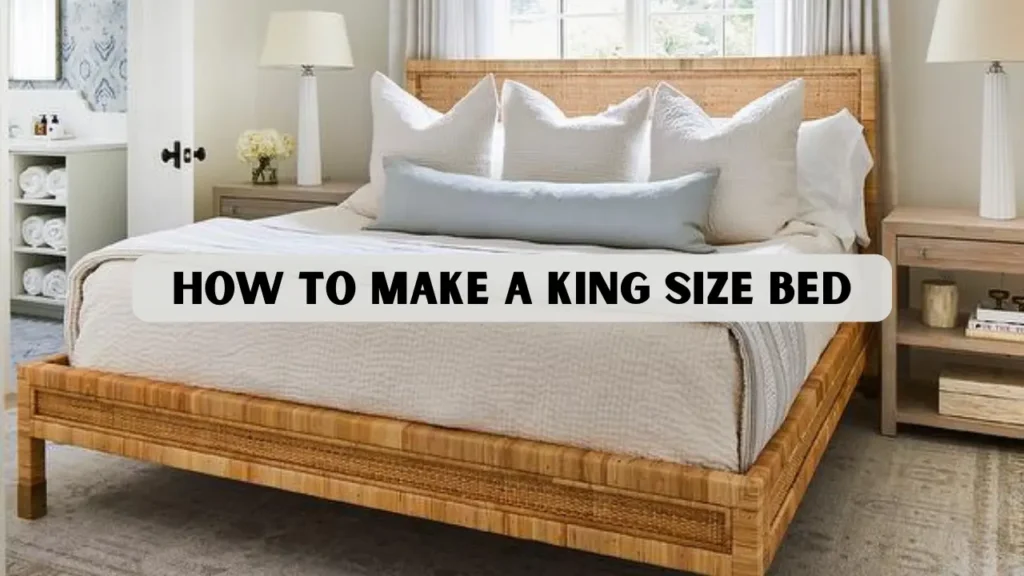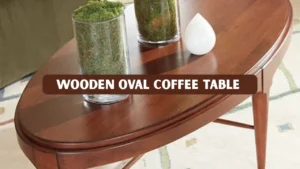Learning how to make a king size bed is one of the most valuable woodworking projects for beginners and intermediate builders. A store-bought king bed frame is often expensive, limited in style, and sometimes poorly reinforced. Building your own allows you to control the design, strength, height, finish, and storage options.
A handmade bed frame has long-term value because you can customize the leg height, choose premium lumber, add a center support for better durability, and style the headboard based on your home’s interior. Unlike mass-produced frames, a strong wooden king bed built with quality joinery will last decades.
This guide combines woodworking principles, practical construction steps, and real-world experience. The structure is simple enough for a beginner but durable enough for advanced users who want a long-lasting piece of furniture.
Key Takeaways
- This guide shows a full and practical step-by-step workflow for how to make a king size bed, including frame layout, cutting, assembly, support structure, and finishing.
- Accurate measurements are essential. A standard king mattress measures 76 inches by 80 inches, and the internal frame should be slightly larger for proper fit.
- The project typically requires one to three weekends, depending on your tools, finishing method, and level of customization.
- The guide includes a complete material list, cut list, safety instructions, troubleshooting tips, and optional design variations.
- The build method is designed to be strong, stable, and appropriate for long-term daily use.
What You Will Build in This King Size Bed Project
When you follow this guide for how to make a king size bed, you will build:
- A solid platform-style king bed frame sized for a standard 76 inch by 80 inch mattress
- A strong rectangular frame built from 2×8 lumber and reinforced with a center support beam
- A choice between multiple support styles, including slats or plywood decking
- An optional headboard made from plywood, trim boards, or upholstered fabric
- A frame height that you can adjust depending on your preferred aesthetic or storage needs
- A finish that suits your decor, such as stain, paint, or clear protective coating
The instructions are written to be easy to follow and beginner-friendly, while maintaining structural integrity for real bedroom use.
Materials and Tools Required
Materials
You can modify lumber size depending on availability and your preferred thickness, but the following list is widely used:
- 4×4 lumber for legs
- 2×8 or 2×10 lumber for side rails
- 2×6 lumber for end rails and center support
- 1×4 or 1×3 lumber for slats
- Optional ¾ inch plywood sheet for a solid deck
- Wood screws in 2.5 inch and 1.5 inch sizes
- Pocket hole screws if using pocket joinery
- Wood glue
- Wood filler
- Sandpaper in 80, 120, and 220 grit
- Finish of your choice (stain, sealer, or paint)
- Felt pads to reduce noise between slats and rails
- Optional metal rail brackets for a removable rail system
Tools
You may use alternative tools depending on your workspace, but the following tools provide the easiest workflow:
- Circular saw or table saw
- Miter saw for accurate crosscuts
- Cordless drill and driver
- Tape measure
- Pocket hole jig (optional but helpful)
- Orbital sander
- Wood clamps
- Carpenter’s square
- Optional router for decorative edges
Material Sourcing
Most lumber and hardware can be purchased from local lumber suppliers or hardware stores. Different wood species offer different aesthetics and durability. Pine is affordable and easy to work with, while oak or poplar provides a stronger and more premium finish.
Design and Measurements
Accurate measurements determine the strength and function of your king bed frame. The standard US king mattress size is 76 inches by 80 inches. The internal frame opening should be approximately 76.5 inches by 80.5 inches to allow easy mattress placement.
Recommended Dimensions
- Internal width: 76.5 inches
- Internal length: 80.5 inches
- Side rail height: 10 to 14 inches above the floor
- Final bed height including mattress: varies depending on mattress thickness and chosen leg height
Support System
A strong support system is essential, especially for larger beds.
- Use one full-length 2×8 center beam or a pair of 2×6 beams
- Add legs under the center beam spaced about 24 to 32 inches apart
- Slats should be spaced 2 to 3 inches apart for proper weight distribution
- Plywood decking can replace slats for more consistent support
Proper reinforcement helps the bed avoid sagging, squeaking, and long-term structural damage.
Cut List (Recommended Starting Point)
This cut list is based on standard lumber dimensions. Always measure your actual lumber and mattress before cutting.
Frame
- 2 side rails: 2×8 cut to 80.5 inches
- 2 end rails: 2×8 cut to 76.5 inches
- 4 legs: 4×4 cut to the height you prefer
- Center support beam: 2×8 cut to 80.5 inches
- Optional headboard rails or trim boards
Slats or plywood deck
- 12 to 14 slats cut to 76 inches
- Or a plywood sheet trimmed to 76 inches by 80 inches
How to Make a King Size Bed
This section details the full step-by-step building process. This is where your main keyword appears as required.
Step 1: Planning and Preparation
Before you begin cutting wood, take time to prepare your workspace and tools. This step prevents mistakes and speeds up assembly.
Important tasks during preparation include:
- Measuring your actual mattress ensures the internal frame size fits perfectly without gaps or tight spots.
- Setting up a clean workspace with sawhorses and clamps provides stability and keeps the build process safer.
- Pre-sanding hidden surfaces if you want a smoother final finish helps your stain or paint apply evenly.
- Gathering all screws, lumber, and glue prevents interruptions and keeps assembly running smoothly.
- Reviewing every step to avoid errors during construction reduces mistakes and keeps you on the correct build sequence.
A well-prepared workspace increases safety and creates a smoother building experience.
Step 2: Building the base frame
The base frame sets the overall shape and stability of your bed.
- Cut the side rails and end rails to their final lengths to ensure a precise fit for your mattress and frame.
- Mark hole locations for screws or pocket holes so your joints are aligned and strong.
- Apply wood glue to joints before fastening to add extra stability and long-lasting strength.
- Assemble the rectangular frame on a flat surface to keep it level and prevent twisting.
- Use clamps and ensure the frame is square so corners meet perfectly and the bed sits evenly.
- Reinforce corners with additional screws if necessary to prevent wobbling and increase durability.
A square, tight frame prevents wobbling and uneven weight distribution.
Step 3: Adding the legs and center support
The legs and center support must be strong because they carry most of the weight of the mattress and sleepers.
- Position each 4×4 leg at each corner to provide stable support for the entire bed frame.
- Attach legs using pocket screws or lag bolts to ensure a strong and durable connection.
- Center a 2×8 beam under the frame to distribute weight evenly across the bed.
- Add 2 or 3 supporting legs beneath the center beam for extra reinforcement and stability.
- Secure everything tightly and check for level alignment so the bed sits flat and does not wobble.
A properly installed center support significantly increases durability.
Step 4: Installing slats or a plywood platform
You can choose between traditional slats or a solid plywood deck.
Using slats
- Space slats evenly across the length of the frame to provide uniform mattress support and prevent sagging.
- Maintain gaps of 2 to 3 inches to allow airflow and keep the mattress well-ventilated.
- Pre-drill screw holes to prevent splitting which protects the wood and ensures a clean, strong joint.
- Add felt pads to reduce sound so the bed frame remains quiet during movement.
Using plywood
- Cut plywood to fit the internal frame opening so it lays perfectly flat and provides full mattress support.
- Sand edges to avoid splintering ensuring a smooth surface that is safe to handle.
- Secure plywood to the frame with countersunk screws to keep it firmly in place and prevent movement.
Step 5: Building and attaching the headboard
Your headboard can be made from plywood, solid wood, or upholstered materials.
Popular options include:
- A plywood panel with decorative trim adds a classic and customizable look to the headboard.
- A stained wooden board arrangement creates a warm, natural aesthetic that highlights the wood grain.
- An upholstered panel using foam and fabric provides a soft, comfortable surface for leaning and relaxing.
Attach the headboard using long bolts or side brackets that allow easy removal. Make sure the headboard is centered and level.
Step 6: Sanding, finishing, and protecting the wood
Good finishing work makes your project look professional.
Follow this sanding sequence:
- 80 grit for shaping removes rough surfaces and helps define the overall shape of the wood.
- 120 grit for smoothing refines the surface, making it ready for a finish coat.
- 220 grit for finishing creates a smooth, polished surface for stain or paint application.
After sanding, remove dust using a tack cloth. Apply stain or paint in thin coats and allow each coat to dry thoroughly. Seal the wood with two coats of polyurethane for maximum durability.
Design Variations and Customization Ideas
Once you learn how to make a king size bed, you can expand the design further.
Ideas include:
- Adding storage drawers under the bed maximizes space and keeps your bedroom organized.
- Creating a floating bed look with hidden support blocks gives a modern, sleek aesthetic to the frame.
- Designing a tall sculpted headboard for a luxurious appearance adds elegance and becomes a focal point in the room.
- Applying decorative trim, molding, or routered profiles enhances the visual appeal and craftsmanship of the bed.
- Using hardwood species like walnut or maple for a premium look provides durability and a high-end finish that lasts for years.
These customizations improve aesthetics and functionality.
Troubleshooting and Common Mistakes
Mistakes can happen, especially for beginners. Here are common problems and solutions:
- Frame wobble: Check for square corners and add internal bracing to ensure the bed remains stable and secure.
- Squeaking sounds: Tighten screws, add felt pads, and ensure slats are secure to eliminate noise and improve comfort.
- Uneven finish: Sand properly and avoid rushing the staining process so the bed looks smooth and professional.
- Center beam sagging: Add more support legs or upgrade the beam to a 2×10 to maintain long-term structural strength.
Safety Guidance
Safety is essential in woodworking.
Follow these tips:
- Wear eye protection and hearing protection to prevent injuries while cutting, drilling, or sanding.
- Keep fingers away from saw blades to avoid serious cuts and ensure safe operation.
- Clamp small pieces before cutting to stabilize the wood and achieve accurate cuts.
- Work in a ventilated area when applying finishes to reduce inhalation of fumes and promote faster drying.
- Follow manufacturer instructions for all tools and chemicals to ensure safety and proper use of materials.
Case Study
A builder created a modern platform king bed using poplar for the frame and oak veneer plywood for the deck. The internal opening measured 76.5 inches by 80.5 inches, and the center beam had legs spaced every 30 inches.
The project required one weekend for cutting and assembly, plus several days for finishing. Six months later, the frame remained stable with no squeaks, demonstrating long-term durability when the bed is built correctly.
Conclusion
Learning how to make a king size bed helps you gain confidence in building durable and long lasting furniture. It allows you to create something sturdy and functional that fits your home perfectly. By taking on a project like this, you avoid the high cost of store bought frames. You also gain skills that you can use for future woodworking tasks.
This project blends basic structural woodworking with simple decorative finishing techniques. It is suitable for beginners who want hands on experience and for intermediate builders seeking a customizable design. You can adjust the height, style, and finishing to match your bedroom look. The result is a strong, attractive bed frame you can be proud of.
FAQs
How much lumber is needed for a king bed?
A basic frame usually requires two 2×8 side rails, two 2×8 end rails, one center beam, several slats, four legs, and optional headboard materials.
Can I build this bed without a table saw?
Yes. A circular saw with a straight-edge guide can perform most cuts.
How long does the project take?
Most builders finish the frame in two or three days, with additional time for applying finish coats.
What mattress size does this guide support?
A standard king mattress measuring 76 inches by 80 inches.
Can beginners follow this plan?
Yes. The structure is simple, and the instructions are written for easy understanding.




